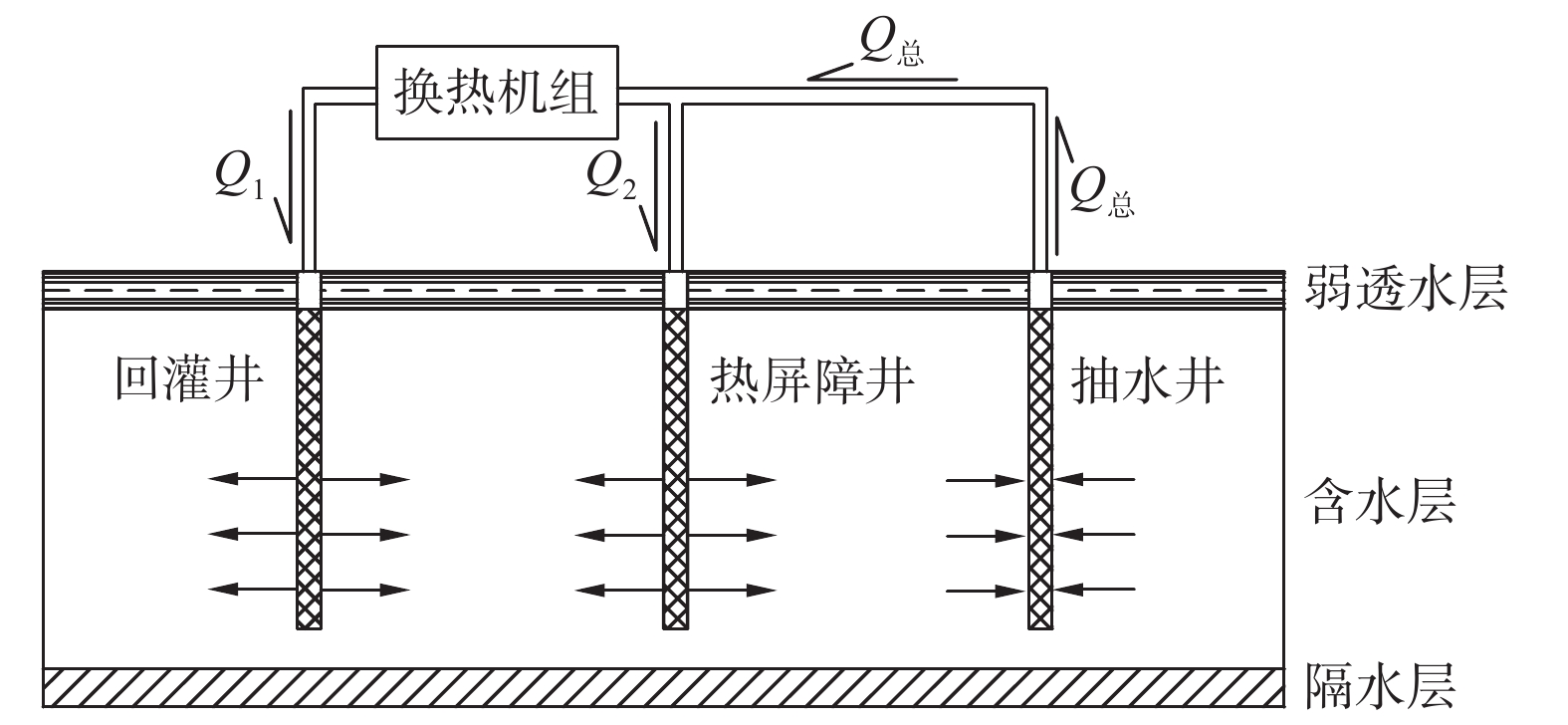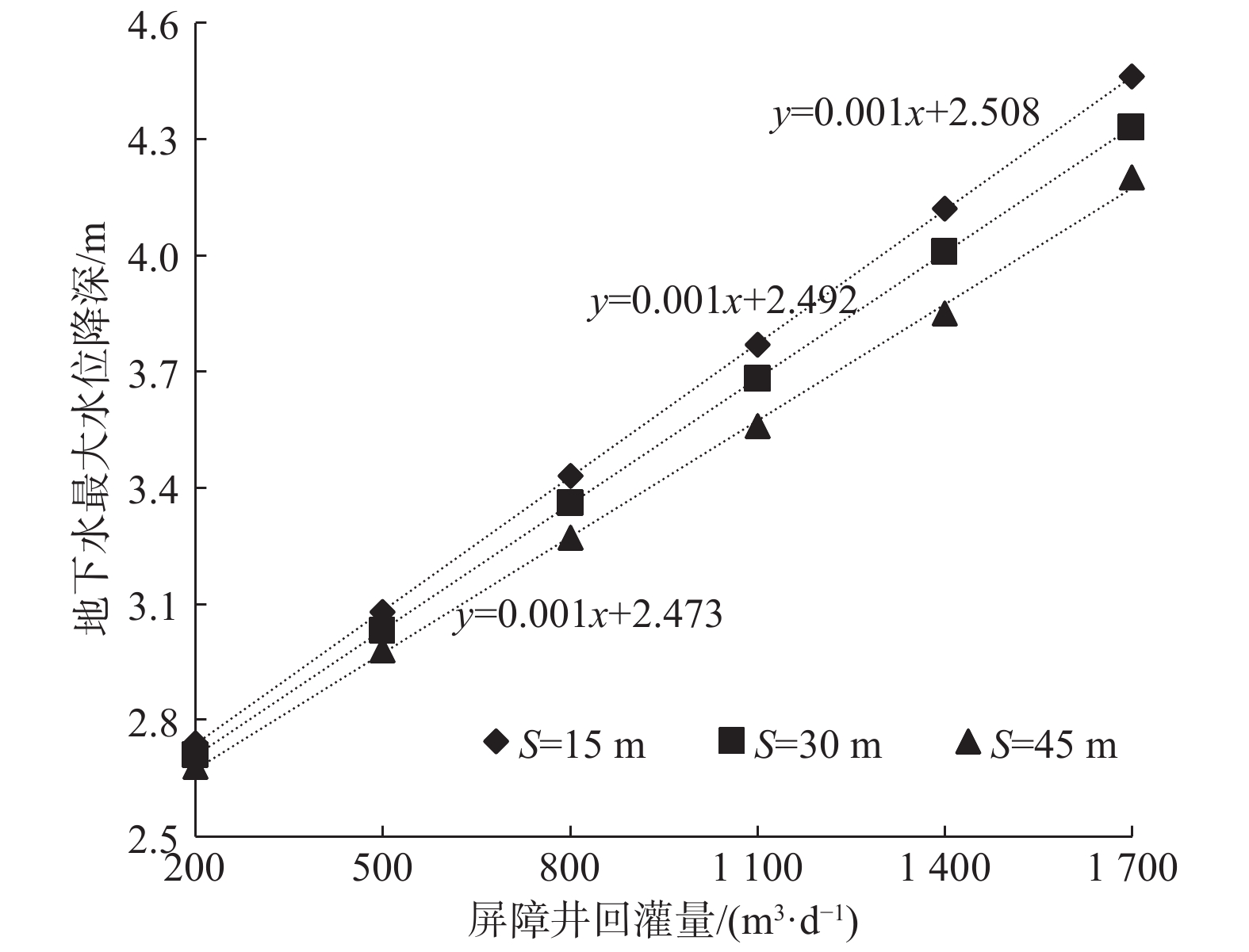Simulation study on the effect of thermal barrier well on the heat transfer of groundwater heat pump
-
摘要:
对于场地受限的地下水源热泵项目,随着系统运行时间的增加易引发热贯通现象进而降低机组运行效率。地下水源热泵设计中,在抽灌水井连线间布设热屏障井可改变地下水流场,降低热量在抽灌井间的运移速度,有利于延长热贯通发生时间并缓解热贯通程度。通过构建地下水换热模型,模拟计算夏季制冷工况条件下36组热泵运行场景,分析了热屏障井的位置,过滤管长度及回灌量对热贯通和含水层温度场的影响规律。结果表明:热屏障井回灌量的增加有利于提升热屏障效果,但提升幅度随回灌量的增加逐渐减弱;最大水位降深值随着热屏障井回灌量的增加呈线性增长;增加热屏障井滤管长度可提升热屏障效果,提升效果随屏障井回灌量的增加逐渐增强。通过模型多周期、长时间模拟计算发现,热屏障井的运行可促使回灌的冷热量集中在回灌井一侧,对于采用冬夏季抽灌井交换运行模式的热泵系统,可充分利用含水层储能,提升机组运行效率。
Abstract:GWHP system is easy to cause the thermal breakthrough which will reduce the operation efficiency, when the site area is small. In the design of GWHP, by setting up a thermal barrier well between the pumping and recharging well can reduce the heat transfer speed between pumping and recharging well, which is conducive to prolonging the occurrence time of thermal breakthrough. 36 groups of GWHP operation scenarios under the cooling condition are simulated through heat transfer model, and the influence of the location, structure and recharge quantity of the thermal barrier well on the thermal breakthrough and the aquifer’s temperature field are analyzed. The results show that the increase of recharge quantity of the thermal barrier well is conducive to improving the thermal barrier effect, but the degree of improvement decreases with the increase of recharge quantity. At the same time, with the increase of recharge quantity, the maximum drawdown will increase linearly. The location of the thermal barrier well has little influence on the aquifer temperature field and the closer the barrier well is to the recharging well, the later the thermal breakthrough time will be. Increasing the length of the filter tube in the heat barrier well can improve the thermal barrier effect, and the effect of the thermal barrier is gradually enhanced with the increase of the recharge quantity. In addition, through the long-time simulation of model, it is found that the operation of the heat barrier well can concentrate the energy near the recharging well. When the GWHP adopts the exchange operation mode of pumping and recharging well, it can make full use of the aquifer energy storage and improve the operation efficiency of heat pump.
-
Key words:
- GWHP /
- heat transfer model /
- thermal barrier well /
- thermal breakthrough
-

-
表 1 模型含水层计算参数
Table 1. The paraments of aquifer in model
计算参数 数值 地下水初始温度T/℃ 12 渗透率k/cm2 3×10−7 给水度u 0.2 孔隙度n 0.3 地下水动力黏度μ/(Pa·s) 1×10−3 地下水比热容Cw/(kJ·kg−1·K−1) 4.2 含水层固体颗粒比热容Cs/(kJ·(kg−1·K−1) 0.7 地下水导热系数λw/(W·m−1·K−1) 0.6 含水层固体颗粒导热系数λs/(W·m−1·K−1) 2.2 地下水密度ρw/(kg·m−3) 998.2 含水层固体颗粒密度ρs/(kg·m−3) 1 900 表 2 热屏障井参数
Table 2. The paraments of thermal barrier well
运行参数 数值 距回灌井长度S/m 15,30,45 滤管长度L/m 5,10,15,20,25,30 回灌水量Q/(m3·d−1) 200,500,800,1100,1 400,1700 -
[1] SANNER B, KARYTSAS C, MENDRINOS D, et al. Current status of ground source heat pumps and underground thermal energy storage in Europe[J]. Geothermics,2003,32(4):579 − 588.
[2] 周彦章, 周志芳, 吴蓉, 等. 地源热泵系统地下水热量运移阶段特性模拟研究[J]. 水文地质工程地质,2011,38(5):128 − 134. [ZHOU Yanzhang, ZHOU Zhifang, WU Rong, et al. Simulation study of the stage-characteristics of groundwater thermal transport in aquifer medium for GWHP System[J]. Hydrogeology & Engineering Geology,2011,38(5):128 − 134. (in Chinese with English abstract)
[3] QI Z S, GAO Q, LIU Y, et al. Status and development of hybrid energy systems from hybrid ground source heat pump in China and other countries[J]. Renewable & Sustainable Energy Reviews,2014,29(7):37 − 51.
[4] 徐生恒, 彭涛, 王秉忱, 等. 地源热泵技术研究新进展[J]. 地下水,2016,38(2):1 − 8. [XU Shengheng, PENG Tao, WANG Bingchen, et al. The new developments of ground source heat pump research[J]. Ground Water,2016,38(2):1 − 8. (in Chinese with English abstract) doi: 10.3969/j.issn.1004-1184.2016.02.001
[5] 刘洪战, 田源, 杨坡. 细颗粒沉积物分布区地下水源热泵抽灌井施工工艺探讨[J]. 水文地质工程地质,2017,44(1):36 − 40. [LIU Hongzhan, TIAN Yuan, YANG Po. A discussion of the construction technology of pumping and injection Wells in the fine particle sediment distribution area[J]. Hydrogeology & Engineering Geology,2017,44(1):36 − 40. (in Chinese with English abstract)
[6] VERDA V, BACCINO G, SCIACOVELLI A, et al. Impact of district heating and groundwater heat pump systems on the primary energy needs in urban areas[J]. Applied Thermal Engineering,2012,40:18 − 26. doi: 10.1016/j.applthermaleng.2012.01.047
[7] 靳孟贵, 汤庆佳, 栗现文. 应用水热运移数值模拟优化地下水源热泵系统抽灌井布局[J]. 地质科技情报,2012,31(5):128 − 135. [JIN Menggui, TANG Qingjia, LI Xianwen. Optimum location of pumping and injection Wells of groundwater heat exchange system using numerical modeling of water and heat transport[J]. Geological Science and Technology Information,2012,31(5):128 − 135. (in Chinese with English abstract)
[8] 周强, 王楠. 基于FLOW HEAT的地下水源热泵一抽多灌井群优化布置数值研究[J]. 水电能源科学,2019,37(9):124 − 127. [ZHOU Qiang, WANG Nan. Numerical simulation of ground-water heat pump system of pumping with multi-irrigation based on FLOW HEAT[J]. Water Resources and Power,2019,37(9):124 − 127. (in Chinese with English abstract)
[9] 傅志敏, 向衍, 高西望. 井点布置对采能区地下水温度场的影响[J]. 华北水利水电大学学报(自然科学版),2010,31(6):34 − 38. [FU Zhimin, XIANG Yan, GAO Xiwang. Influences of well point arrangement on ground water temperature field in energy mining areas[J]. Journal of North China Institute of Water Conservancy and Hydroelectric Power,2010,31(6):34 − 38. (in Chinese with English abstract)
[10] GALGARO A, CULTRERA M. Thermal short circuit on groundwater heat pump[J]. Applied Thermal Engineering,2013,57(1):107 − 115.
[11] PAKSOY H, ANDERSSON O, ABACI S, et al. Heating and cooling of a hospital using solar energy coupled with seasonal thermal energy storage in an aquifer[J]. Renewable Energy,2000,19(1):117 − 122.
[12] 吕天奇, 张延军, 于子望, 等. 地下水源热泵系统和太阳能辅助热源系统的地温场数值模拟研究[J]. 探矿工程(岩土钻掘工程),2018,45(1):79 − 83. [LYU Tianqi, ZHANG Yanjun, YU Ziwang, et al. Numerical simulation study on geothermal field of ground water heat pump system and solar assisted heat source system[J]. Exploration Engineering (Rock & Soil Drilling and Tunneling),2018,45(1):79 − 83. (in Chinese with English abstract)
[13] 朱小波, 李幽铮, 周彦章. 地源热泵系统冷负荷设计方案变化地下水热量运移模拟[J]. 勘察科学技术,2010(5):13 − 17. [ZHU Xiaobo, LI Youzheng, ZHOU Yanzhang. Simulation of groundwater thermal migration for GWHP system with different cooling load design[J]. Site Investigation Science and Technology,2010(5):13 − 17. (in Chinese with English abstract) doi: 10.3969/j.issn.1001-3946.2010.05.003
[14] RUSSO S L, TADDIA G, BACCINO G, et al. Different design scenarios related to an open loop groundwater heat pump in a large building: Impact on subsurface and primary energy consumption[J]. Energy & Buildings,2011,43(2):347 − 357.
[15] NORIO T, KASUMI Y, GEORGE Z. Model study of the thermal storage system by FEHM code[J]. Geothermics,2003,32(4):603 − 607.
[16] 王洋, 王小清, 吕亮. 基于监测数据的地下水源热泵系统运行策略优化[J]. 水利与建筑工程学报,2019,17(5):153 − 158. [WANG Yang, WANG Xiaoqing, LYU Liang. Operation strategy optimization of groundwater source heat pump based on monitoring data[J]. Journal of Water Resources and Architectural Engineering,2019,17(5):153 − 158. (in Chinese with English abstract)
[17] SHELDON H A, SCHAUBS P M, RACHAKONDA P K, et al. Groundwater cooling of a supercomputer in Perth, Western Australia: hydrogeological simulations and thermal sustainability[J]. Hydrogeology Journal,2015,23(8):1831 − 1849. doi: 10.1007/s10040-015-1280-z
[18] 彭涛, 孙铁, 王秉忱, 等. 地下水人工流场能效增强技术在浅层地热能开发中的应用[J]. 水文地质工程地质,2017,44(6):169 − 174. [PENG Tao, SUN Tie, WANG Bingchen, et al. The energy efficiency enhancement technique of soil source heat pump system through groundwater artificial flow field[J]. Hydrogeology & Engineering Geology,2017,44(6):169 − 174. (in Chinese with English abstract)
[19] 赵军, 张志英, 刘九龙, 等. 人工流场影响下地埋管管群换热的模拟研究[J]. 天津大学学报(自然科学与工程技术版),2016,49(8):835 − 840. [ZHAO Jun, ZHANG Zhiying, LIU Jiulong, et al. Simulation study on heat transfer of buried pipe banks under the influence of artificial flow field[J]. Journal of Tianjin University(Science and Technology),2016,49(8):835 − 840. (in Chinese with English abstract)
[20] 杨露梅, 鄂建, 朱明君, 等. 典型地埋管系统模拟工况地温场特征研究[J]. 水文地质工程地质,2017,44(2):178 − 183. [YANG Lumei, E Jian, ZHU Mingjun, et al. Characteristics of the ground temperature of the typical Ground-Source Heat Pumps system in Nanjing[J]. Hydrogeology & Engineering Geology,2017,44(2):178 − 183. (in Chinese with English abstract)
[21] 岳丽燕, 孟令军, 赵苏民, 等. 天津市浅层地热能存在的热堆积问题及解决方法探讨[J]. 地质调查与研究,2017,40(1):76 − 80. [YUE Liyan, MENG Lingjun, ZHAO Sumin, et al. The cold & heat accumulation problem and solution methods of the shallow geothermal resource in Tianjin[J]. Geological Survey and Research,2017,40(1):76 − 80. (in Chinese with English abstract) doi: 10.3969/j.issn.1672-4135.2017.01.011
[22] 朱天奎. 地下含水层蓄能特性模拟实验研究[D]. 长春: 吉林大学, 2013.
ZHU Tiankui. Simulation experiment research on storage characteristic of underground aquifer[D]. Changchun: Jilin University, 2013.(in Chinese with English abstract)
[23] 孔祥言, 李道伦, 徐献芝, 等. 热-流-固耦合渗流的数学模型研究[J]. 水动力学研究与进展(A辑),2005,20(2):269 − 275. [KONG Xiangyan, LI D Lianlun, XU Xianzhi, et al. Study on the mathematical models of coupled thermal-hydrological-mechanical (THM) processes[J]. Journal of Hydrodynamics,2005,20(2):269 − 275. (in Chinese with English abstract)
[24] 张永杰, 束龙仓, 温忠辉, 等. 人工回灌对地下水年龄分布规律的影响[J]. 水文地质工程地质,2018,45(1):8 − 14. [ZHANG Yongjie, SHU Longcang, WEN Zhonghui, et al. Effect of artificial recharge on groundwater age distribution[J]. Hydrogeology & Engineering Geology,2018,45(1):8 − 14. (in Chinese with English abstract)
[25] 曹潇元, 侯德义, 胡立堂. 甘肃北山区域地下水流数值模拟研究[J]. 水文地质工程地质,2020,47(2):9 − 16. [CAO Xiaoyuan, HOU Deyi, HU Litang. Numerical simulation of regional groundwater flow in the Beishan area of Gansu[J]. Hydrogeology & Engineering Geology,2020,47(2):9 − 16. (in Chinese with English abstract)
[26] 李宏卿, 曾昭发, 刘四新, 等. 基于COMSOL Multiphysics的长白山天池多物理场耦合响应研究[J]. 地球物理学进展,2017,32(4):1779 − 1783. [LI Hongqing, ZENG Zhaofa, LIU Sixin, et al. Study on coupling response of multiphysical field around Tianchi lake of Changbaishan volcano based on COMSOL Multiphysics[J]. Progress in Geophysics,2017,32(4):1779 − 1783. (in Chinese with English abstract) doi: 10.6038/pg20170449
[27] 陈响亮. 抽灌井群热交互性及其布控特性研究[D]. 长春: 吉林大学, 2011.
CHEN Xiangliang. Study on thermal interaction and its control in the field of pumping/injecting well groups[D]. Changchun: Jilin University, 2011. (in Chinese with English abstract)
[28] 高青, 周学志, 江彦, 等. 地能利用过程抽灌井区热贯通及其定量分析[J]. 应用基础与工程科学学报,2012,20(3):447 − 454. [GAO Qing, ZHOU Xuezhi, JIANG Yan, et al. Quantitative analysis of thermal breakthrough in pumping and injecting well group area during earth energy utilization[J]. Journal of Basic Science and Engineering,2012,20(3):447 − 454. (in Chinese with English abstract) doi: 10.3969/j.issn.1005-0930.2012.03.012
-




 下载:
下载:








